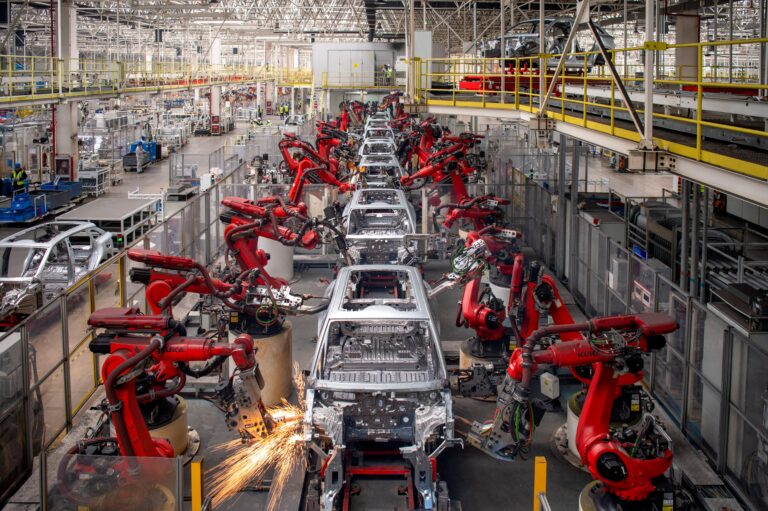China’s factory activity showed signs of cooling in May, as the impact of renewed U.S. tariffs begins to weigh on manufacturing output and export orders. According to the latest official data released on Thursday, key indicators pointed to a slowdown in industrial expansion, highlighting growing challenges for China’s export-driven economy amid escalating trade tensions with Washington. The report underscores increasing headwinds for manufacturers as businesses navigate rising costs and uncertain demand on the global stage.
China Factory Output Declines Amid Rising US Tariff Pressures
China’s manufacturing sector experienced a noticeable slowdown in May, reflecting growing headwinds from escalating US tariffs. Industrial output contracted as export orders weakened, signaling cautious sentiment among manufacturers amid an intensifying trade dispute. Several key sectors, including electronics and automotive parts, reported declines in production volumes due to disrupted supply chains and reduced foreign demand.
- Electronics: Output down by 4.2%
- Automotive parts: Production dropped 3.7%
- Steel manufacturing: Declined 2.5%
Moreover, factory orders showed a marked reduction, highlighting the dampening effect of tariffs on both domestic and international buyers. Companies have begun to reassess investment plans, with many seeking alternatives outside China to mitigate tariff-related costs. The slowdown raises concerns over the broader impact on China’s economic growth, which has heavily relied on industrial manufacturing as a key driver.
| Sector | May Output Change (%) | Impact |
|---|---|---|
| Electronics | -4.2 | Reduced export orders |
| Automotive Parts | -3.7 | Supply chain disruptions |
| Steel Manufacturing | -2.5 | Decreased domestic demand |
Impact on Supply Chains and Export Competitiveness Explored
The recent cooling in China’s factory activity signals notable disruptions within global supply chains. Increased US tariffs have compelled manufacturers to reassess their cost structures and production timelines, with delays and higher expenses becoming more prevalent. Key components and intermediate goods are now facing longer lead times, affecting industries reliant on just-in-time inventory practices. This strain extends beyond China’s borders, as international buyers grapple with unpredictable delivery schedules and escalating prices.
Consequences for export competitiveness are becoming increasingly visible. Chinese exporters are forced to absorb additional tariffs or pass costs onto consumers, which risks undermining their market position against competitors from tariff-exempt regions. The complexity of navigating these trade barriers has also accelerated a shift toward supply chain diversification, including relocating certain production lines to Southeast Asia or Mexico. Businesses highlight several emerging challenges:
- Rising input costs due to tariff-induced price adjustments
- Disruptions in component availability impacting assembly lines
- Pressure to enhance supply chain resilience and flexibility
- Strategic reallocation of production to maintain global market share
| Impact Area | Short-Term Effect | Long-Term Outlook |
|---|---|---|
| Manufacturing Costs | +8% increase in input prices | Potential shift to lower-cost regions |
| Supply Chain Lead Times | Up to 15% longer delays | Improved diversification & redundancy |
| Export Volumes | 5% decline in key export sectors | Gradual adaptation to new markets |
Strategies for Chinese Manufacturers to Mitigate Tariff-Driven Challenges
Chinese manufacturers are increasingly adopting diversified sourcing and production strategies to cushion the impact of US tariffs. By relocating segments of their supply chains to countries with more favorable trade agreements, such as Vietnam or Indonesia, companies reduce reliance on direct exports to the US, thereby minimizing tariff exposure. Additionally, many factories are investing in automation and technology upgrades to improve operational efficiency, offsetting tariff-induced cost increases through productivity gains.
Key tactics include:
- Expanding into alternative export markets to diversify customer bases
- Enhancing product value by focusing on high-tech and niche sectors less vulnerable to tariffs
- Utilizing bonded warehouses and free trade zones to defer tariffs and streamline logistics
| Strategy | Benefit | Example |
|---|---|---|
| Supply Chain Relocation | Tariff Reduction | Shifting assembly to Southeast Asia |
| Automation Investment | Cost Efficiency | Robotic production lines |
| Niche Market Focus | Higher Margins | Advanced electronics |
The Way Forward
As China’s manufacturing sector shows signs of slowing amid sustained US tariffs, analysts will be closely watching upcoming economic data to gauge the broader impact on global trade. The cooling factory activity in May underscores the challenges facing China’s export-driven industries as geopolitical tensions continue to influence market dynamics.




